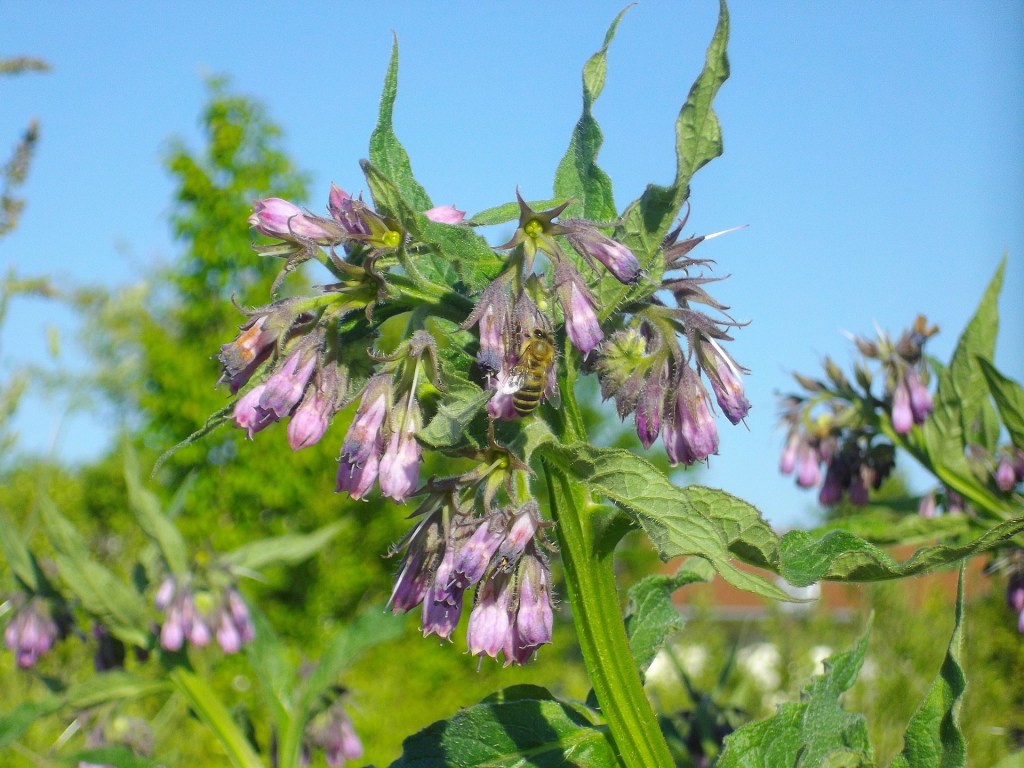| Plants That Say No Go Buddy – Not On My Shift! Predatory and Companion Plants The beauty and benefits of companion planting. Techniques to introduce different flowers, plants and herbs with an attitude that can support and improve soil conditions, increase fertility, offer shelter and attract and repel insects simultaneously. |

| Comfrey |
| I have been growing comfrey as a herb since 2018. I introduced the plant to a previous garden as a trial because l had heard that it had many benefits for both gardening and composting. You may not be familiar with comfrey. It is known for two primary purposes – organic gardening and organic medicinal as in herbal properties. In so far as the garden goes, this wonderfully versatile plant serves us well with mulching and soil enrichment, fertilisers, composting activators as well as accelerator primers and gardening teas. In my eyes, that is a wild bounty of use! With the living plant, you can harvest the leaves and either chop them up with the sole purpose of digging into the soil as a soil enrichment and solid fertiliser or lay the leaves on top of the earth near to plants as a mulcher. Either a living mulcher in green leaves or a dead leaf mulcher. You can gather the leaves up, dry them, and then shred or crush them to act as a nutritious leaf mould potting compost material. The comfrey leaves are famous for the amount of potassium they hold, which is nearly three times more than farmyard manure – which is extraordinary! But equally, they are rich in phosphorus and nitrogen, and when all three are combined, this makes for an ideal growing medium for plants. The other beauty to the comfrey is that it can be harvested quite progressively during the season, and the leaves will regrow. |
| Comfrey Plant Uses |
| Digging it into the soil By digging a trench in your flower beds, vegetable beds, or even raised beds, you can lay comfrey leaves on the bottom of the trenching and cover them with soil and plant on top. Over time, the leaves will leech the nutrients into the ground and the plant roots. |
| Adding it to your compost as an activator Dead, ageing or fresh comfrey leaves can be added to your compost pile at any stage or layer level. As they decompose/decompose further, they will encourage and promote the heating up process and, as such, help speed along with the composting. If you are maintaining ‘leaf mould’ productions, the addition of the leaves will aid the process of leaf decline and destruction. This particular form of leaf mould is ideal for potting composts. |
| Comfrey Compost Tea Making comfrey tea is no different to other teas. Harvest the plant leaves, chop up or add whole to a watertight bin or container. I use rubbish bins and add sufficient water to cover the leaves themselves. Leave to steep for between 4 – 8 weeks, and hey presto – your comfrey tea will be ready! However, a word of warning – when making fertiliser/compost tea, have your containers outback somewhere – they can make quite noxious and nauseous smells!. There is no need to dilute this mixture – you can either add the rotted leaves to your compost and dig over or continue to add fresh leaves to the container leaving the old ones where they are. |
| Mulcher Place the leaves dead or alive as in ageing or freshly harvested around the plants themselves to a depth of between 3-5cm – the nutrients will seep into the soils – but equally, the leaves will act as a weed reducer. Bumblebees seem to love the presence of comfrey; l have also seen bees and butterflies stop for a while as well. |
| Hope you enjoyed this article and l’ll see you again soon. The Autistic Composter |






I have seen the plant but I had no idea how is called or what it does 😉🌱
LikeLiked by 1 person
Hey Ribana, it’s a really useful plant 🙂
LikeLiked by 1 person
A very useful herb.
LikeLiked by 1 person
Hey Sadje, yes very much so 🙂
LikeLiked by 1 person
👍🏼👍🏼👍🏼
LikeLiked by 1 person
Most interesting, Rory! I wasn’t aware of its usefulness in gardening.
LikeLiked by 1 person
Hey Betty it is indeed a marvelous plant and herb both 🙂
LikeLiked by 1 person
I have a huge bunch growing under the mango tree – which was failing until I put the comfrey in.
LikeLiked by 1 person
Hey Cage, wowo that is interesting so the presence of the comfrey in the soil was also a great boost for the mango?
LikeLiked by 1 person
It definitely made a difference – and the avo, too. The soil here makes for good bricks, but the comfrey roots go way deep, so maybe the air they take into the clay allows the tree roots to go down there with them when the comfrey dies off during winter.
LikeLiked by 1 person
That is interesting, and yet when l think back to where l have comfrey planted in the gardens, l too can vouch thta the plant does enrich the companions. I hadn’t thought about it till you made mention. This year the comfrey was planted down in a shaded area and the Lemon Balm beside it which struggled the previous year was truly alive this year.
LikeLiked by 1 person